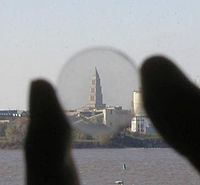
Photo from wikipedia
This work investigates the structure and chemical states of thin-film coatings obtained by pulsed laser codeposition of Mo and C in a reactive gas (H2S). The coatings were analysed for… Click to show full abstract
This work investigates the structure and chemical states of thin-film coatings obtained by pulsed laser codeposition of Mo and C in a reactive gas (H2S). The coatings were analysed for their prospective use as solid lubricating coatings for friction units operating in extreme conditions. Pulsed laser ablation of molybdenum and graphite targets was accompanied by the effective interaction of the deposited Mo and C layers with the reactive gas and the chemical states of Mo- and C-containing nanophases were interdependent. This had a negative effect on the tribological properties of Mo–S–C–H nanocomposite coatings obtained at H2S pressures of 9 and 18 Pa, which were optimal for obtaining MoS2 and MoS3 coatings, respectively. The best tribological properties were found for the Mo–S–C–H_5.5 coating formed at an H2S pressure of 5.5 Pa. At this pressure, the x = S/Mo ratio in the MoSx nanophase was slightly less than 2, and the a-C(S,H) nanophase contained ~8 at.% S and ~16 at.% H. The a-C(S,H) nanophase with this composition provided a low coefficient of friction (~0.03) at low ambient humidity and 22 °C. The nanophase composition in Mo–S–C–H_5.5 coating demonstrated fairly good antifriction properties and increased wear resistance even at −100 °C. For wet friction conditions, Mo–S–C–H nanocomposite coatings did not have significant advantages in reducing friction compared to the MoS2 and MoS3 coatings formed by reactive pulsed laser deposition.
Journal Title: Nanomaterials
Year Published: 2020
Link to full text (if available)
Share on Social Media: Sign Up to like & get
recommendations!